Czech cuisine
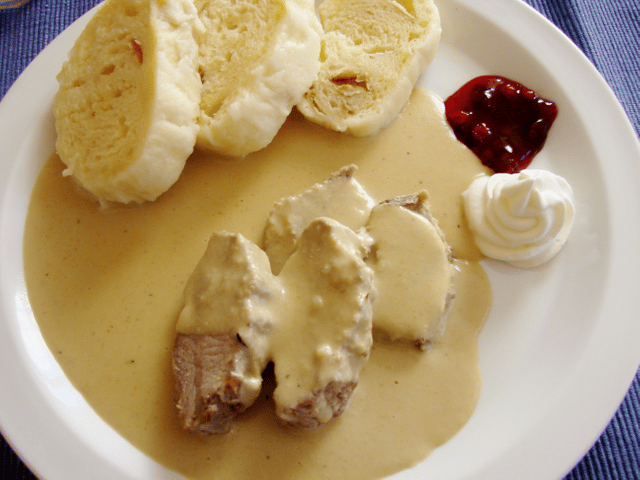
Czech cuisine

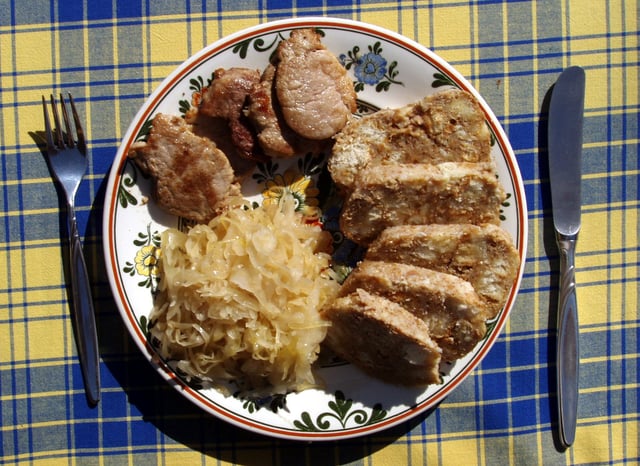
Vepřo-knedlo-zelo (Roast pork with dumplings and sauerkraut)
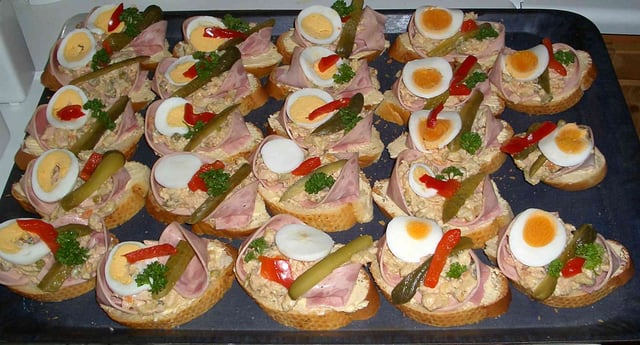
Obložené chlebíčky, a type of snack or appetizer
Czech cuisine (Czech: česká kuchyně) has both influenced and been influenced by the cuisines of surrounding countries and nations. Many of the cakes and pastries that are popular in Central Europe originated within the Czech lands. Contemporary Czech cuisine is more meat-based than in previous periods; the current abundance of farmable meat has enriched its presence in regional cuisine. Traditionally, meat has been reserved for once-weekly consumption, typically on weekends. The body of Czech meals typically consists of two or more courses; the first course is traditionally soup, the second course is the main dish, and the third course can include supplementary courses, such as dessert or compote (kompot). In the Czech cuisine, thick soups and many kinds of sauces, both based on stewed or cooked vegetables and meats, often with cream, as well as baked meats with natural sauces (gravies), are popular dishes usually accompanied with beer, especially Pilsner, that Czechs consume the most in the world. Czech cuisine is also very strong in sweet main courses and desserts, a unique feature in European cuisines.
Side dishes
Dumplings (knedlíky) (steamed and sliced bread-like) are one of the mainstays of Czech cuisine and are typically served with meals. They can be either wheat or potato-based, and are sometimes made from a combination of wheat flour and dices made of stale bread or rolls. Puffed rice can be found in store-prepared mixtures. Smaller Czech dumplings are usually potato-based. When served as leftovers, sliced dumplings are sometimes pan-fried with eggs. Czech potato dumplings are often filled with smoked meat and served with spinach or sour cabbage. Fried onion and braised cabbage can be included as a side dish.
There are many other side dishes, including noodles (nudle) and boiled or risotto rice (rýže or rizoto), which is sometimes served in the form of rice pudding (rýžový nákyp). Potatoes (brambory) are served boiled with salt, often with caraway seed and butter, pork fat or oil. Peeled and boiled potatoes are mixed into mashed potatoes (bramborová kaše). New potatoes are sometimes boiled in their skins, not peeled, from harvest time to new year. Because of the influence of foreign countries, potatoes are also fried, so French fries and croquettes are common in restaurants.
Buckwheat (pohanka), pearl barley (kroupy) and millet grains (jáhly) are rarely served in restaurants. These are more commonly a home-cooked, healthier alternative. Pasta (těstoviny) is common, either baked, boiled, cooked with other ingredients or served as a salad. Pasta is available in different shapes and flavours. This is an influence of Italian and Asian cuisine. Rice and buckwheat noodles are not common, but are becoming more popular. Gluten-free pasta is also available, made from corn flour, corn starch or potatoes.
Breads and pastries
Bread (chléb or chleba) is traditionally sourdough baked from rye and wheat, and is flavoured with salt, caraway seed (kmín), onion, garlic, seeds, or pork crackling. It is eaten as an accompaniment to soups and dishes. It is also the material for Czech croutons and for topinky—slices of bread fried in a pan on both sides and rubbed with garlic. Rolls (rohlík), buns (žemle), and braided buns (houska) are the most common forms of bread eaten for breakfast; these are often topped with poppy seeds and salt or other seeds. A bun or a roll baked from bread dough is called a dalamánek. A sweet roll or loupák is a crescent-shaped roll made from sweetened dough containing milk. It is smeared with egg and sprinkled with poppy seeds before baking, giving it a golden-brown colour.
Soups
Soup (polévka, colloquially polívka) plays an important role in Czech cuisine. Soups commonly found in Czech restaurants are beef, chicken or vegetable broth with noodles—optionally served with liver or nutmeg dumplings; garlic soup (česnečka) with croutons—optionally served with minced sausage, raw egg, or cheese; and cabbage soup (zelňačka) made from sauerkraut—sometimes served with minced sausage. Kyselica is a Wallachian variety and contains sour cream, bacon, potatoes, eggs and sausage.
Pea (hrachovka), bean (fazolová) and lentil soups (čočková polévka) are commonly cooked at home. Goulash soup (gulášovka) and dršťková are made from beef or pork tripe (dršťky) cut into small pieces and cooked with other ingredients; the meat can be substituted with oyster mushrooms. Potato soup (bramboračka) is made from potato, onion, carrot, root parsley and celeriac, spiced with caraway seed, garlic and marjoram. Fish soup (rybí polévka) made with carp is a traditional Christmas dish.
Other common Czech soups are champignon or other mushroom soup (houbová polévka), tomato soup (rajská polévka), vegetable soup (zeleninová polévka), onion soup (cibulačka) and bread soup (chlebová polévka). Kulajda is a traditional South Bohemian soup containing water, cream, spices, mushrooms, egg (often a quail's egg), dill and potatoes.[1] It is typical in its thickness, white color and characteristic taste. The main ingredient is mushrooms, which gives it the dish's scent. Kyselo is a regional specialty soup made from rye sourdough, mushrooms, caraway and fried onion.
Meat dishes
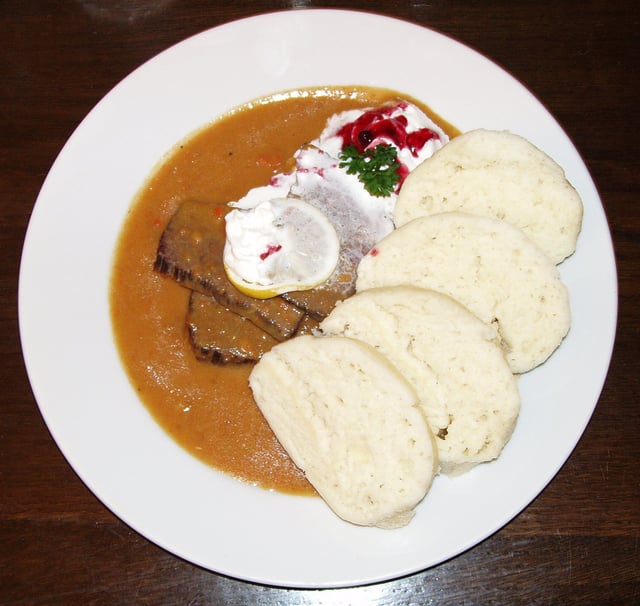
Svíčková na smetaně (Marinated sirloin), served here with dumplings and cream
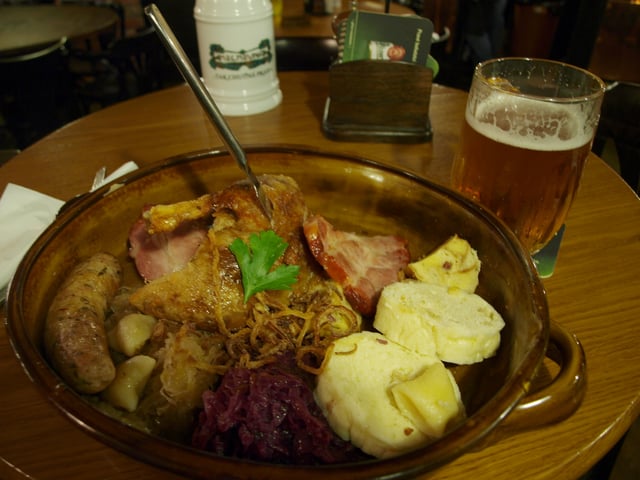
A "traditional Bohemian platter" at restaurant Kolkovna in central Prague, consisting of roast duck, roast pork, beer sausage, smoked meat, red and white cabbage, bread, bacon and potato dumplings.
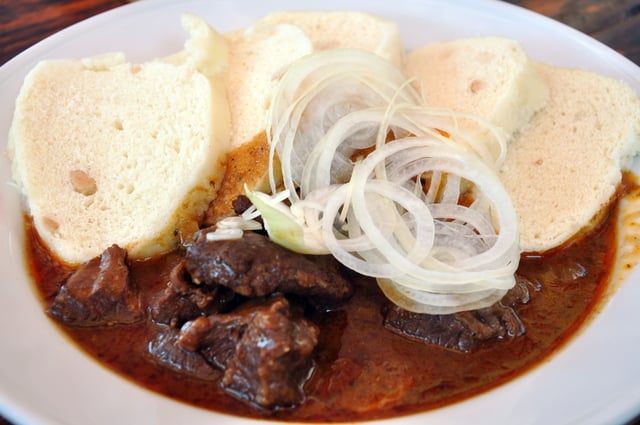
Prague-style beef goulash
Traditional Czech dishes are made from animals, birds or fish bred in the surrounding areas.
Pork is the most common meat, making up over half of all meat consumption.[2] Beef, veal and chicken are also popular. Pigs are often a source of meat in the countryside, since pork has a relatively short production time, compared to beef.
Jitrnice is the meat and offal of pork cut into tiny pieces, filled in a casing and closed with sticks. Meat from the neck, sides, lungs, spleen, and liver are cooked with white pastry, broth, salt, spices, garlic and sometimes onions. Klobása, known as Kielbasa in the United States, is a smoked meat sausage-like product made from minced meat. It is spicy and durable. Jelito is a pork meat sausage-like product containing pork blood and pearl barley or pastry pieces. Tlačenka is a meat or poultry product consisting of little pieces of meat in jelly/aspic from connective tissue boiled into mush, served with onion, vinegar and bread. Ovar is a simple dish made from rather fatty pork meat (head or knuckle). These pieces of lower quality meat are boiled in salted water. Pork cracklings (škvarky) and bacon (slanina) are also eaten.
In restaurants one can find:
Guláš—a stew usually made from beef, pork or game with onions and spices. It is usually accompanied with knedlík or sometimes bread. It is also traditionally served at home as a pot of guláš will last for several days. Czech guláš is not to be confused with Hungarian "gulyás", which is a soup more similar to Czech gulášovka (a soup). Pörkölt is the Hungarian equivalent of Czech guláš.
Roast pork with dumplings and cabbage (pečené vepřové s knedlíky a se zelím, colloquially vepřo-knedlo-zelo) is often considered the most typical Czech dish.[3] It consists of cabbage and is either cooked or served pickled. There are different varieties, from sour to sweet.
Marinated sirloin (svíčková na smetaně or simply svíčková; svíčková is the name for both the sauce and the meat (pork side or beef side) used for this dish; na smetaně means in cream, and it means that the svíčková sauce is with cream. Braised beef, usually larded, with a svíčková sauce—a thick sauce of carrot, parsley root, celeriac and sometimes cream. This dish is often served with knedlíky, chantilly cream—sweet, whipped cream—cranberry compote (kompot) and a slice of lemon.
Baked mincemeat (Sekaná pečeně)—later only mincemeat (sekaná), is a dish made from minced pork meat (beef is also possible).
Ham (šunka) is made from pork or beef, braised, dried or smoked.
Schnitzel (Řízek, plural řízky) is a Czech meat dish. The word means "sliced/cut (out) piece". These are usually small slices of veal, pork or chicken covered with Czech trojobal 'triplecoat', made from putting and pressing a piece pounded and sliced into smooth flour on both sides, then covered in whisked egg and breadcrumbs and fried on both sides. Řízek is served with potato side-dishes. The Czech triplecoat is used in some households at Christmas to cover carp or trout decorated with lemon slices.
Karbanátek (plural karbanátky) is a burger usually made from pork, beef, minced fish or other meat. It is often mixed with egg and commonly crumbled with Czech triplecoat. It can be vegetable-based with pastry pieces or flour and in both versions fried on both sides or baked.
Smoked meat (uzené) with potato dumplings, fried onion and cooked spinach.
Beef with tomato sauce (rajská omáčka or rajská) is served with dumplings. Dill sauce (koprová omáčka or koprovka) is often on menus too.
Rabbit (králík) is commonly bred in the countryside. Hare (zajíc) with wild game is also served. Mutton, lamb, kid, boar, horse or deer are not as common.
Commonly-found poultry dishes are:
Goose (husa), duck (kachna), turkey (krůta) and chicken (kuře). Pheasant (bažant), partridge (koroptev), guinea (perlička), pigeon (holub) and other game birds are not as common.
Roast duck (pečená kachna) is served with bread or potato dumplings and braised red cabbage.
Chicken in paprika sauce (kuře na paprice) or hen in paprika sauce (slepice na paprice) is chicken or hen stewed with onion, paprika and cream.
Roast turkey with bacon (krocan pečený na slanině) is turkey larded with, or wrapped in bacon, roasted with bacon and butter; it is not very common.
Fish—mostly trout (pstruh) and carp (kapr)—is commonly eaten at Christmas. Otherwise many fish are imported, including sardines, fillet, salmon, tuna, and anchovy. Other types of fish are slowly becoming popular too. Crayfish (rak) used to be very common in rivers, but are nowadays rarer and are protected. Prawns or lobsters are imported instead.
Other dishes
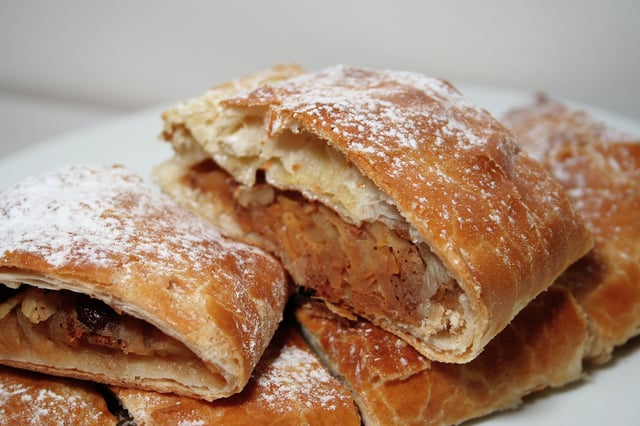
Apple Štrúdl
Mushrooms are often used in Czech cuisine as different types grow in the forests. Czechs make an average of 20 visits to the forest annually, picking up to 20,000 tonnes of mushrooms.[4] Bolete, parasol and other kinds of mushroom are often found. In the shops, you can buy common mushrooms (žampiony), oyster mushrooms (hlívy), shiitake, Jew's ear and dried forest mushrooms. Smaženice are shallow-fried mushrooms with onion and spices. Mushroom Jacob (Houbový Kuba) is a dish prepared from cooked hulled grain (barley), then strained, mixed with cooked mushrooms, fried onion, garlic, fat and black pepper, and baked in the oven. It is served at Christmas. Mushrooms are often triple-coated and fried. Cauliflower can be fried in the Czech triplecoat.
Homemade noodles with ground poppy seeds are called nudle s mákem; these are served with powdered sugar and melted butter. A similar dish is potato buns with poppy seeds (bramborové šišky s mákem), and are called cones (šišky), because they resemble the cones of coniferous trees.
Omelettes (omeleta) are often served with peas.
Pancakes (palačinky) of plate size or palm size are common.
The most traditional vegetables are carrots, celery, parsley, turnip, cauliflower, salad, onion, leek, garlic, cabbage, kale and chives. In gardens, one can also find tomatoes, bell peppers, courgettes, pumpkins, melons, sunflowers, poppies, potatoes and beet.
Peas (hrách) and lentils (čočka) are, together with bean pods, the most common. They are served as soup or as cooked mash with pickled cucumber and fried onion, occasionally with sausage or smoked meat. Šoulet (shoulet) is a mix of boiled peas with barley, fat and other ingredients.
Žemlovka is a baked dish made with layers of sliced rolls or buns called žemle, sliced apples and milk or eggs. It is served with cinnamon and raisins.
Štrúdl or závin (Strudel) can be sweet with apples, raisins, walnuts, grated coconut or cherry—or savoury with cabbage, spinach, cheese or meat.
Semolina porridge (krupicová kaše) is served with sugar, honey, cinnamon or cocoa with butter on the top. Optionally, sliced apples or apricots are added as toppings. Healthier versions substitute semolina for oatmeal or rice.
Bell peppers (plněné papriky) are stuffed with meat or rice with vegetables.
Lečo or Lecsó is a stew made from peppers, onions, tomatoes and spices.
Spaghetti (špagety) is coming in as an Italian influence.
Eggs are often used in Czech cuisine because many families outside of cities breed hens. Scrambled eggs (míchaná vajíčka) are common. Fried eggs (volské oko, literally "bulls eye") are often served with bread or potatoes and spinach. Boiled eggs are also popular. Stuffed eggs are made from halved, shelled, hard-boiled eggs. The yolk is carefully removed into a separate bowl, mixed with salt, mustard and spices and stuffed back. It can be decorated.
Dairy products (mléčné výrobky) have their place in Czech cuisine too. Eidam (Edam, Edammer) is a Dutch-based type of cheese and Niva is a Czech blue cheese. A common pub food, nakládaný hermelín, or pickled cheese, is a cheese similar to Camembert that is aged in olive oil and spices. Typically served with bread and an assortment of fresh vegetables. Sour cream is commonly used as part of various cream-based sauces.
Snacks
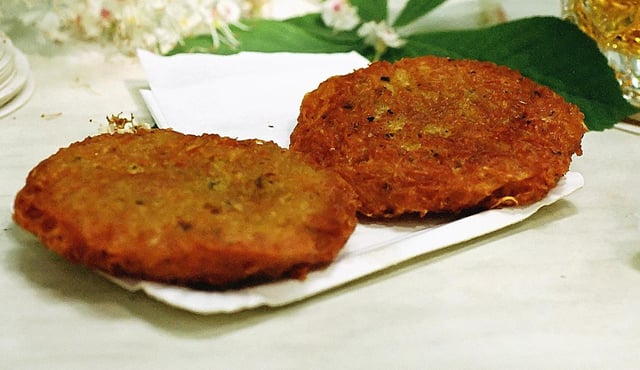
Fried bramboráky (potato pancakes)
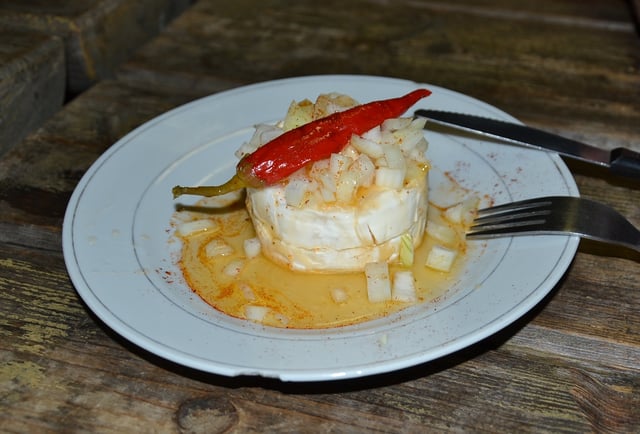
Nakládaný hermelín (marinated cheese)
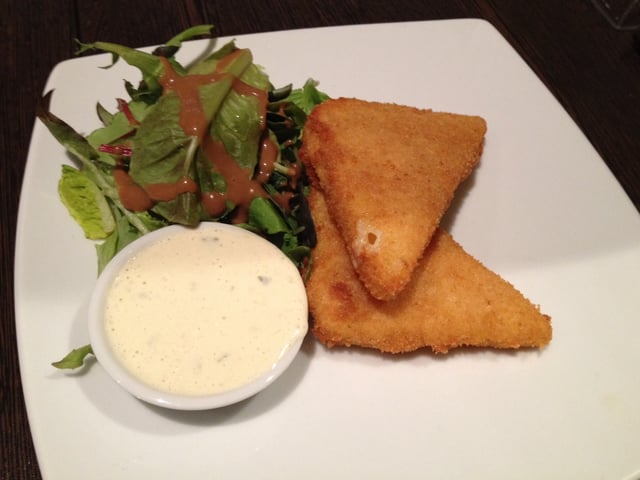
Fried cheese (Smažák), served with tartar sauce and side salad.
Bramboráky (regionally called cmunda or vošouch in Pilsen and strik or striky in Czech Silesia) are fried pancakes similar to rösti made of grated raw potato, flour, carrots or sour cabbage, and rarely sausage. They are spiced with marjoram, salt, pepper, and garlic, and usually sized to fit the cooking dish. Smaller variants are often eaten as a side dish.
Utopenci, singular utopenec (literally "drowned men"), are piquantly pickled bratwursts (špekáčky) in sweet-sour vinegar marinaded with black pepper, bay leaf, onion and chili peppers. They are often available in Czech pubs, but are uncommon in better restaurants.
Nakládaný Hermelín is a soft cheese, from the same family as brie and camembert, marinated with peppers and onions in oil. It is a pub-food.
Smažený sýr (colloquially Smažák), is a fried cheese battered in Czech triplecoat — usually Edam (also Hermelín), about 1 cm thick coated in flour, egg and bread crumbs like Wiener schnitzel, fried and served with tartar sauce (tatarská omáčka) and potatoes or french fries.
Beer cheese (pivní sýr) is a soft cheese, usually mixed with raw onions and mustard, which is spread onto toasted bread. It is also a pub-food.
Open sandwiches, known as obložené chlebíčky ("garnished breads") or chlebíčky, are not made from normal Czech bread, but from roll-like, bigger pastry called veka, sliced and garnished.[5] They may be served with mayonnaise, ham, egg, fish, salads or spreads on the top.[5] They are usually decorated with fresh sliced or pickled cucumber, tomato, red or yellow bell pepper, sliced radish, or parsley. Jednohubky are similar to obložené chlebíčky, but smaller and in many varieties. All are served in a small amount—one mouthful impaled on a stick.[5]
Olomoucké syrečky or "tvarůžky" is an aged cheese with a strong odour. It is made in and sold from Loštice, a small town in Moravia. The tradition of making this cheese dates back to the 15th century.[6] Tvarůžky can be prepared in a number of ways—it can be fried, marinated, or added to Bramboráky.
Dried apple chips (křížaly) and dried banana chips.
Potato, beet and celery chips (crisps) are common snacks.
Roasted peanuts are common.
The "Czech hot dog" (párek v rohlíku) is a street food consisting of boiled or steamed sausage dipped in mustard or ketchup served in a roll with a hole made inside, not in a sliced bun like the common hot dog. It is influenced by German cuisine.
Langoše (fried bread) are influenced by Hungarian cuisine. They are usually served with garlic, Edam cheese and ketchup, or some combination of the three.
Sweets
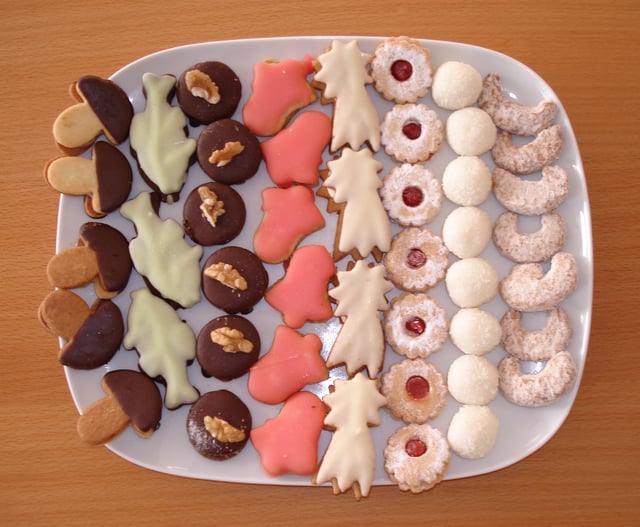
Christmas cookies (vánoční cukroví)
Fruit dumplings (ovocné knedlíky) are mostly made using plums (švestkové knedlíky), apricots (meruňkové knedlíky) or strawberries (jahodové knedlíky). These are whole fruits or pieces of fruit coated with potato or curd dough and steamed, then served with butter or cream, sugar and sometimes milled poppy seeds or tvaroh (Quark). They are usually eaten as a main dish.
Kolache (koláče) is a type of mainly round yeast pastry consisting of fillings of fruit, curd, poppy seeds or doughnut. It can be small, middle or pancake sized (mostly in Moravia). Fillings can be seen.
Buchty is a yeast pastry similar to koláče; the same filling is wrapped in pieces of dough and baked, but is not visible in the final product.
Sweet dumplings with custard sauce (buchtičky se šodó) are traditional Czech little buchty without filling. The recipe comes from Czech roots, however, the bordering countries—mainly Slovakia, Poland, and Hungary—consider buchtičky se šodó as food that came from their country.
Puding is a flavoured custard combined in layers. Puding is served in a glass topped with fruit or shaped in a mould.
Braided bread (Vánočka) and buns (mazanec) are prepared for Christmas, along with many kinds of biscuits and Christmas sweets (vánoční cukroví). Vánočka and mazanec are the same type of pastry as Jewish Challah.
Easter Lamb (Velikonoční beránek) is prepared for Easter. The dough is from eggs, sugar and flour. Lemons can be added. It is baked in a mould in the shape of a lamb. It can be decorated.
Bábovka is from dough similar to that used for Easter Lamb, often with cocoa dough in the middle. It is round, 10–15 cm high, made in a mould and is often served with coffee.[7]
Pancakes (palačinky) are rolled with marmalade or jam and often served with ice cream.
Lívance are smaller types of pancakes prepared with yeast in the batter. They are eaten with jam or warm forest fruits.
Vdolky and koblihy—see List of doughnut varieties.
Perník is made in two ways: Like gingerbread, but without ginger. It is decorated with shapes; popular themes are heart shapes, three-dimensional cottages and even whole decorated villages are made—especially in the Pardubice Region where the tradition was established in the 16th century.[8][[INLINE_IMAGE|//upload.wikimedia.org/wikipedia/commons/thumb/4/4a/Makovy_frgal.jpg/220px-Makovy_frgal.jpg|//upload.wikimedia.org/wikipedia/commons/thumb/4/4a/Makovy_frgal.jpg/330px-Makovy_frgal.jpg 1.5x, //upload.wikimedia.org/wikipedia/commons/thumb/4/4a/Makovy_frgal.jpg/440px-Makovy_frgal.jpg 2x||h214|w220|thumbimage]] Larger koláč, so called "frgál" (plural frgály), baked at Moravian Wallachia area Like a cake with cinnamon and honey.
Roláda is a sponge cake roulade filled with jam.
Bublanina is a sponge cake made in a baking sheet with fruit (2–3 cm tall).
Litá (poured) bublanina is a pancake-like batter poured onto a baking sheet. Pieces of fruit—apples, pears or cherries—measuring 1x2 cm are spread on it and it is then sprinkled with sugar.
Makovec is a sponge cake with ground poppy seeds.
Mrkvanec is a sponge cake with grated carrots.
With the exception of koláče, vánoční cukroví and velikonoční beránek, sweets are consumed with tea or coffee in the late afternoon break, rather than immediately after a main meal. Koláče are commonly eaten at breakfast.
Míša is a treat made out of frozen curd; it is popular with children and has been produced since 1961.
Beverages
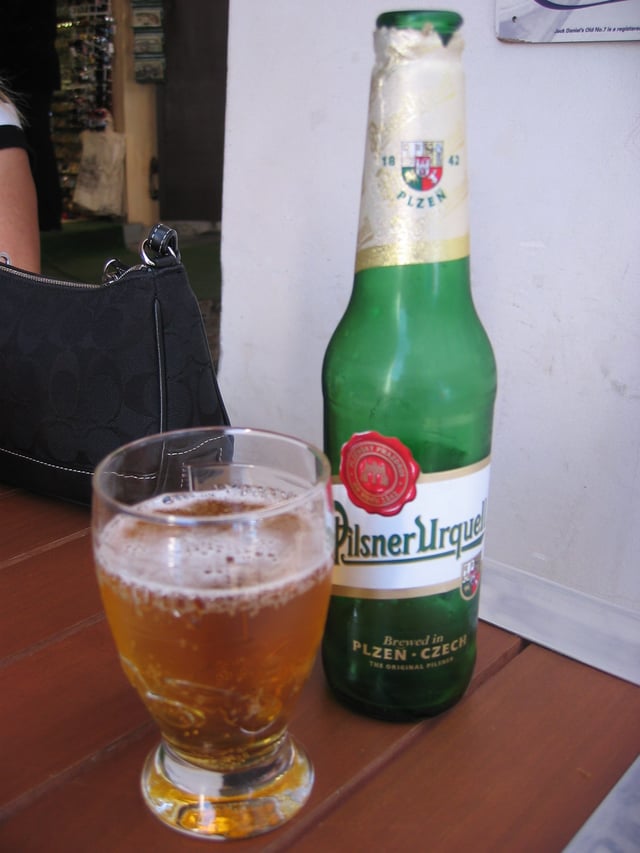
Pilsner Urquell served in Prague
Czech republic has highest per-capita consumption of beer in the world. Most common style, which originated here, is Pilsner. Aside from beer, Czechs also produce wine mostly in the region of Moravia and a unique liquors— Becherovka. Czech Slivovitz and other Pálenka (fruit brandies) are traditionally distilled in the country and are considered national drink. More recently new drinks became popular, among them Tuzemák, traditionally marketed as "Czech rum", is made from potatoes or sugar beets. A mixed drink consisting of Becherovka and tonic water is known under the portmanteau of Beton ("concrete"). Another popular mixed drink is Fernet Stock mixed with tonic, called "Bavorák" or "Bavorské pivo" (literally "Bavarian beer"). Kofola is a non-alcoholic Czech soft drink somewhat similar in look and taste to Coca-Cola, but not as sweet. Kofola was invented in communist Czechoslovakia as a substitute to the Coca-Cola that they would not import, but it became so popular that production has continued well past the end of communism in the country.[9]
See also
Beer in the Czech Republic
Slovak cuisine